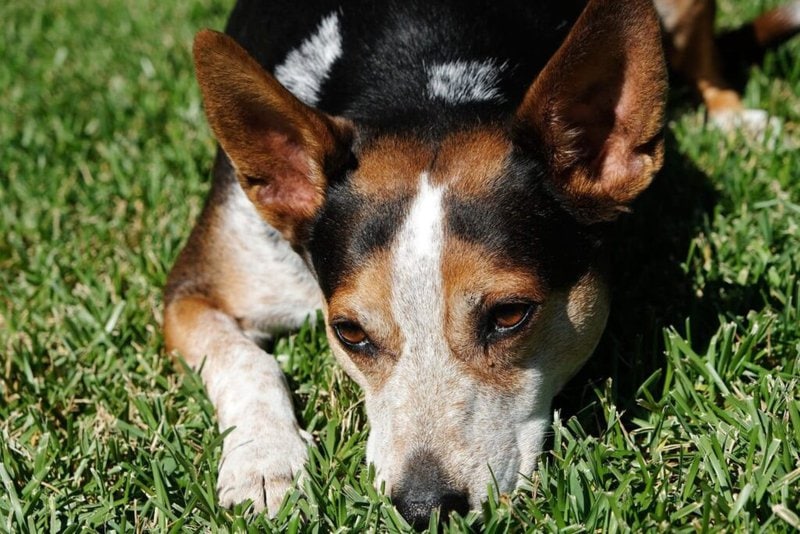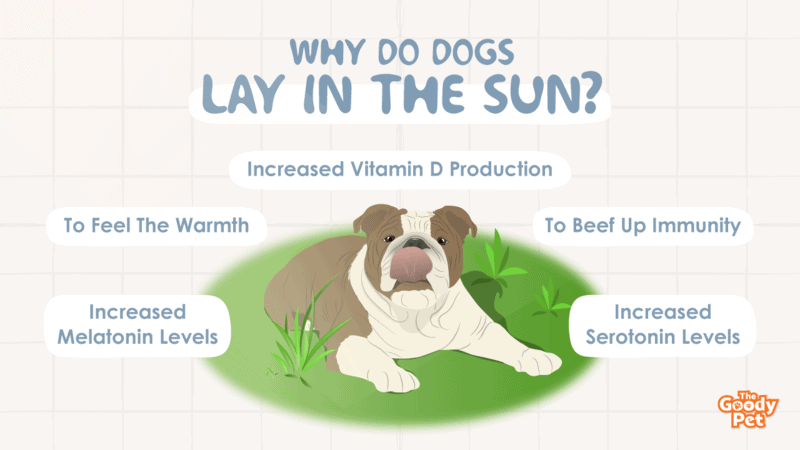Nothing beats waking up in the morning with the sun brightly shining, welcoming us to a new and productive day ahead of us. This is especially refreshing after continuous days of overcast skies. But, it’s not only us, humans, who love this kind of weather, but our canine buddies, as well.
How many times have you seen your pooch lying in its favorite spot and basking in the sun for a few minutes? Not all fur parents have the slightest idea why their dogs do this behavior. Well, the secret is out now.
Dogs lay in the sun because it’s a good way to boost vitamin D levels in their system. Vitamin D is an essential nutrient that regulates both the calcium and phosphorus in their bodies.
Add to that, it’s no secret that sunlight plays a major role in lifting our moods, and that also goes for our pooches. Laying in the sun improves mood, resulting in happier and less anxious fur babies.
Since today is a bright and sunny day, we’ve decided to talk lengthily about the various reasons why you see your dog laying and enjoying the sun. Is there such a thing as getting too much sunlight? What are the potential dangers if your dog sunbathes for too long? Let’s begin our understanding of the secret behind sunbathing.
Why Does My Dog Like To Bathe In The Sun?

There are many reasons why your dog loves laying in the sun.
Apart from vitamin D, sunbathing also enhances serotonin and melatonin levels. Laying in the sun also builds their immune systems. Not to forget that sunbathing regulates your dog’s body temperature, especially during the cold months.
Let’s get into these reasons more clearly one by one.
Increased Vitamin D Production
Just like us, our dogs need sunlight to process some fats and oils into vitamin D.
Deficiency in vitamin D can turn your dog’s health into a topsy turvy. Conditions like cancer and osteoarthritis can inflict damage on your dog as a result.
It’s because vitamin D is the one responsible for absorbing calcium and phosphorus. So, even if your dog has healthy levels of calcium, this is just wasted if there’s a deficiency in vitamin D.
Take note that our dogs have a slightly different way of getting vitamin D from the sun. If we fur parents easily absorb vitamin D through our skin, the process is a bit longer for our fur babies.
Vitamin D that is generated through sun exposure is stored in the sebaceous glands on their coats or hair.
If you’re a keen observer, you will notice that your dog’s grooming behavior increases during and after sunbathing. This is because the only time its body absorbs vitamin D is when it begins licking those body parts.
You can compare it to us orally taking our vitamin pills, except that, for our dogs, it is through grooming themselves that they get the much-needed vitamin D.
Increased Serotonin Levels
Are you familiar with the seasonal affective disorder or SAD? This is a depressive state that usually occurs between late fall and winter and then tapers off during the summer months.
You might be surprised to learn that, yes, dogs are more likely to experience seasonal affective disorder as a result of lack of sunlight exposure.
Most of the dogs that are affected by SAD are the ones living in the Northern parts of the world. The common symptoms of SAD are lethargy, weight gain, and irritability.
So, if you see your dog laying in the sun, one possible explanation is because there’s a need for it to increase its serotonin levels. This is a hormone responsible for stabilizing the mood, transforming your grumpy dog into a happier and livelier canine buddy.
Increased Melatonin Levels
Another hormone that can affect mood is melatonin which is manufactured in the pineal gland.
Melatonin is correlated with the circadian rhythm, an internal clock that affects our dogs’ sleep cycles. But, the pineal gland is light sensitive, meaning less sunlight exposure equates to less production of melatonin.
Lower levels of melatonin result in poor sleep quality. Similar to us, fur parents, if we don’t get enough sleep, we wake up feeling grumpy and unable to function productively.
To Beef Up Immunity
Our dogs are intelligent creatures, and they know the sun has healing powers. For example, senior dogs that suffer from arthritis sunbathe because heat gives them temporary relief from pain.
And what about those fungal and yeast infections that thrive well in dark and damp areas of our dogs’ bodies? Sunshine kills germs, yeast, and fungal infections by drying these up and hastening the healing process.
To Feel The Warmth
Laying in the sun also helps your dog maintain its basal temperature, more so during the colder months. Exposing themselves to sunshine makes them feel good and comfortable.
How Long Should Dogs Lay In The Sun?

20 to 30 minutes twice a day is enough for your dog to reap the sun’s benefits. It can be longer for larger dogs, and 40 minutes is a good number.
Ideally, it’s best for your dog to sunbathe for about 30 minutes early in the morning. To be followed-up 15 minutes during midday, and lastly, 15 minutes or thereabouts in the late afternoon.
Take note that the sun produces varying levels of UVB and UV light. Both of these have an effect on the circadian rhythm of your dog.
UV is the one that causes skin sunburn, so that’s between 11 am and 3 pm. This is why we only recommend a max of 15 minutes of sun exposure at midday.
Dog Breeds And Sun Exposure
Brachycephalic dog breeds like Pug and Pekingese have a low tolerance to heat. These dogs have a hard time cooling off under hot and humid conditions. That said, if you have a brachycephalic dog, do not allow it to lay under the sun for too long. Less than 30 minutes twice a day is good enough.
The same is true for dogs with black fur. It’s because their dark coat absorbs more heat, making them more susceptible to overheating compared to light-colored dogs. However, white-skinned or light-colored dogs are more prone to sunburn and skin cancer. The same is true for hairless dog breeds like the Chinese Crested.
That said, as a rule of thumb, if you yourself had enough of sitting out in the sun, you could be certain that it goes the same for your pooch.
But, what if your dog is a certified sun-worshipper? If that’s the case, you might as well use a dog-safe sunscreen on your pooch to avoid skin problems.
Is It Bad For Dogs To Sunbathe?
As we’ve seen earlier, sunlight does a lot of good things for your pooch. But, of course, laying in the sun has to be done in moderation, lest your dog is at risk for dehydration, heatstroke, and sunburn.
Dehydration
After sunbathing, it’s important that your dog drinks a lot of water to replenish lost fluids. If you fail to provide an ample supply of drinking water, dehydration is a dangerous condition. The signs to watch out for are:
- Lethargy
- Weakness
- Sunken eyes
- Sticky gums
If these signs are addressed early on, dehydration can be reversed before serious health problems appear in the picture.
Heatstroke
Prolonged sun exposure without adequate amounts of water intake can result in the shutdown of body organs. In the worst-case scenario, a dog can die from heatstroke.
If the temperature is at its scorching level, do not allow your pooch to go out of the house. Some of the signs of heatstroke are the following:
- Weakness
- Collapse
- Vomiting and diarrhea
- Seizure

Sunburn
There are some fur parents who have the notion that dogs’ skin does not get sunburned. On the contrary, despite having fur, it’s not enough to protect them from prolonged sun exposure, especially between 10 am and 4 pm.
Some of the common body parts for our pooches to get sunburnt are the following:
- Belly
- Ear tips
- Bridge of the nose
- The skin around their lips
If your dog is continuously exposed to sunlight, it’s possible that it can get skin cancer. The most common type of skin cancer in dogs is squamous cell carcinoma (SCC).
To prevent those health issues, ensure that your dog has access to shades while sunbathing. Instinct would ‘tell’ your pooch to seek shade when the heat gets unbearable.
Vitamin D Toxicity
Though vitamin D plays a huge role in the well-being of your dog, too much of it can also be detrimental.
Fat-soluble compounds, like vitamin D, cannot be easily eliminated through urine. If there’s an abundance of vitamin D, it is stored in fat tissues, eventually causing problems like kidney failure.
Though sunbathing won’t harm your dog, keep in mind that its daily food is most likely supplemented with vitamin D.
Having said that, too much vitamin D from sunshine plus an abundance of vitamin D supplements from food could be a health problem in the long run.
What are the signs that your dog has too much vitamin D in its system?
- Increased water intake
- Increased urination
- Excessive drooling
- Weight loss
Luckily, if vitamin D toxicity is caught early on, it is typically treatable.





